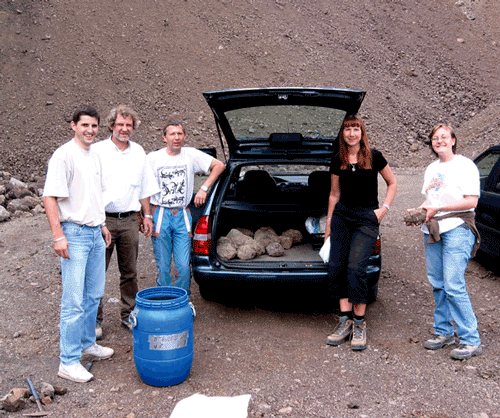introducing GEMOC
|
|||||
| "funding, like a good investment portfolio has a healthy diversity ... across competitive traditional schemes, ... to substantial industry collaborative projects, provision of value-added products to the mineral exploration and ... the ... DEST Systemic Infrastructure Intitiative ... [grant of] over $5 million" | GEMOC's Context A short history of GEMOC: The National Key Centre for the Geochemical Evolution and Metallogeny of Continents (GEMOC) formally commenced in January, 1996 and was funded under the Key Centre scheme for 6 years. Under the government regulations for this round of Key Centres, there was no provision for extension of Commonwealth Key Centre funding beyond the six-year term. A detailed business plan was required in the application to demonstrate how the Centre could continue and maintain its identity after the Commonwealth funding term. This business plan has succeeded and the evolved GEMOC started its new phase in 2002 with an independent well-funded base for the next five years. GEMOC's funding base from 2002: This funding, like a good investment portfolio, has a healthy diversity ranging across competitive traditional schemes such as those available from the Australian Research Council to substantial industry collaborative projects, provision of value-added products to the mineral exploration industry (see the section on Industry Interaction) and one-off opportunities such as the competitive DEST Systemic Infrastructure Initiative that granted over $5 million to enable GEMOC's Technology Development Program to stay at the forefront (see the section on Technology Development). GEMOC's linkages and alliances: GEMOC was initially based on the pre-1995 collective profiles of the core participants at Macquarie and the networked group at ANU (Faculties), with collaborative links to CSIRO, AGSO (now Geoscience Australia (GA)) and colleagues at other Australian Universities. GEMOC has diversified and expanded from this base with shifts in the original linkages. The industry- and technology-related projects evolved to become the strongest links with ANU, especially with Professor Bruce Chappell's relocation to Macquarie. Interaction with CSIRO and GA has grown and transformed over the six years. Strong new national and international collaborative links and programs have extended from the original core activities and participants of GEMOC. |
||||
|
MISSION
|
|||||
| increasing industry collaboration with funded projects related to lithosphere evolution and crustal generation studies has fulfilled one of our major strategic goals of delivering new tools and a new framework of terrane analysis to the minerals exploration industry” | SCIENTIFIC PHILOSOPHY GEMOC’s distinctiveness lies in its interdisciplinary and integrated approach to interpreting Earth’s lithosphere as a 4-dimensional dynamic system (in space and time). This approach links... petrology and geochemistry ~ geophysics ~ petrophysics ~ tectonics ~ numerical modelling within the important contexts of... time (the 4th dimension) and thermal state to understand the significance of large-scale mantle and crustal domains and the processes that have formed and modified them. The front cover of the 2002 Report emphasises the global scale and 3-dimensional context of our lithosphere studies as well as the interface with geophysical datasets. This present-day timeslice of the seismic character of the deep Earth cannot give us the time perspective to unravel over 4 billion years of Earth’s evolution. However, this is provided by the petrological samples of the mantle delivered to the Earth’s surface at different (and measurable) times by tectonism or magmatism. Parallel advances in the integration of geophysical and geochemical information to model and image the lithosphere and its properties continue to be driven by our intense curiosity to solve more of the intriguing questions about how the Earth has evolved, especially now that we have developed many novel geochemical tools to date important events in the mantle and crust and have made so many fundamental new discoveries about the life and times of lithospheres (see Research Highlights and Technology Development sections). These advances mesh with end-user needs and the knowledge required to solve major geological problems. GEMOC's strategic focus The main targets of GEMOC's founding activities were defined to be large-scale problems related to lithosphere evolution and understanding the relevance of different types of crust-mantle domains to area selection for mineral exploration. Despite the coincidence of GEMOC's term with a time of increasingly contracting activities in the mineral exploration climate, our industry interaction has steadily increased and now forms a significant part of the ongoing funding. Our industry interaction is largely based in strong collaboration; interchange of concepts and discussions on GEMOC strategies relevant to industry needs is invaluable in maintaining our focus on industry relevance. The increasing industry collaboration with funded projects related to lithosphere evolution and crustal generation studies has fulfilled one of our major strategic goals of delivering new tools and a new framework of terrane analysis to the minerals exploration industry. Some of these new tools and concepts are summarised in the Research Highlights, and the Technology Development section. |
||||
Part of the French Connection in the field in the Massif Central. |
 |
||||
|
STRATEGIC OUTCOMES
|

 GEMOC ARC National Key Centre
GEMOC ARC National Key Centre.gif)
.gif)
.gif)
.gif)